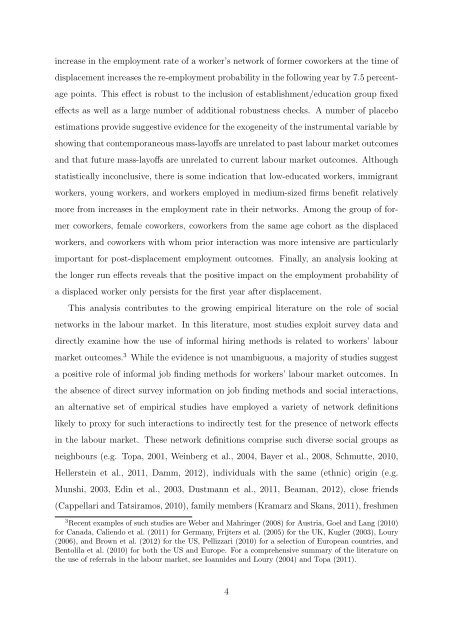paper - Universitat Pompeu Fabra
paper - Universitat Pompeu Fabra
paper - Universitat Pompeu Fabra
Create successful ePaper yourself
Turn your PDF publications into a flip-book with our unique Google optimized e-Paper software.
increase in the employment rate of a worker’s network of former coworkers at the time of<br />
displacement increases the re-employment probability in the following year by 7.5 percentage<br />
points. This effect is robust to the inclusion of establishment/education group fixed<br />
effects as well as a large number of additional robustness checks. A number of placebo<br />
estimations provide suggestive evidence for the exogeneity of the instrumental variable by<br />
showing that contemporaneous mass-layoffs are unrelated to past labour market outcomes<br />
and that future mass-layoffs are unrelated to current labour market outcomes. Although<br />
statistically inconclusive, there is some indication that low-educated workers, immigrant<br />
workers, young workers, and workers employed in medium-sized firms benefit relatively<br />
more from increases in the employment rate in their networks. Among the group of former<br />
coworkers, female coworkers, coworkers from the same age cohort as the displaced<br />
workers, and coworkers with whom prior interaction was more intensive are particularly<br />
important for post-displacement employment outcomes. Finally, an analysis looking at<br />
the longer run effects reveals that the positive impact on the employment probability of<br />
a displaced worker only persists for the first year after displacement.<br />
This analysis contributes to the growing empirical literature on the role of social<br />
networks in the labour market. In this literature, most studies exploit survey data and<br />
directly examine how the use of informal hiring methods is related to workers’ labour<br />
market outcomes. 3 While the evidence is not unambiguous, a majority of studies suggest<br />
a positive role of informal job finding methods for workers’ labour market outcomes. In<br />
the absence of direct survey information on job finding methods and social interactions,<br />
an alternative set of empirical studies have employed a variety of network definitions<br />
likely to proxy for such interactions to indirectly test for the presence of network effects<br />
in the labour market. These network definitions comprise such diverse social groups as<br />
neighbours (e.g. Topa, 2001, Weinberg et al., 2004, Bayer et al., 2008, Schmutte, 2010,<br />
Hellerstein et al., 2011, Damm, 2012), individuals with the same (ethnic) origin (e.g.<br />
Munshi, 2003, Edin et al., 2003, Dustmann et al., 2011, Beaman, 2012), close friends<br />
(Cappellari and Tatsiramos, 2010), family members (Kramarz and Skans, 2011), freshmen<br />
3 Recent examples of such studies are Weber and Mahringer (2008) for Austria, Goel and Lang (2010)<br />
for Canada, Caliendo et al. (2011) for Germany, Frijters et al. (2005) for the UK, Kugler (2003), Loury<br />
(2006), and Brown et al. (2012) for the US, Pellizzari (2010) for a selection of European countries, and<br />
Bentolila et al. (2010) for both the US and Europe. For a comprehensive summary of the literature on<br />
the use of referrals in the labour market, see Ioannides and Loury (2004) and Topa (2011).<br />
4
















